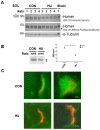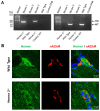Reciprocal Homer1a and Homer2 Isoform Expression Is a Key Mechanism for Muscle Soleus Atrophy in Spaceflown Mice
- PMID: 35008503
- PMCID: PMC8744925
- DOI: 10.3390/ijms23010075
Reciprocal Homer1a and Homer2 Isoform Expression Is a Key Mechanism for Muscle Soleus Atrophy in Spaceflown Mice
Abstract
The molecular mechanisms of skeletal muscle atrophy under extended periods of either disuse or microgravity are not yet fully understood. The transition of Homer isoforms may play a key role during neuromuscular junction (NMJ) imbalance/plasticity in space. Here, we investigated the expression pattern of Homer short and long isoforms by gene array, qPCR, biochemistry, and laser confocal microscopy in skeletal muscles from male C57Bl/N6 mice (n = 5) housed for 30 days in space (Bion-flight = BF) compared to muscles from Bion biosatellite on the ground-housed animals (Bion ground = BG) and from standard cage housed animals (Flight control = FC). A comparison study was carried out with muscles of rats subjected to hindlimb unloading (HU). Gene array and qPCR results showed an increase in Homer1a transcripts, the short dominant negative isoform, in soleus (SOL) muscle after 30 days in microgravity, whereas it was only transiently increased after four days of HU. Conversely, Homer2 long-form was downregulated in SOL muscle in both models. Homer immunofluorescence intensity analysis at the NMJ of BF and HU animals showed comparable outcomes in SOL but not in the extensor digitorum longus (EDL) muscle. Reduced Homer crosslinking at the NMJ consequent to increased Homer1a and/or reduced Homer2 may contribute to muscle-type specific atrophy resulting from microgravity and HU disuse suggesting mutual mechanisms.
Keywords: Homer isoform switch; NMJ adaptation; hindlimb unloading; microgravity; muscle atrophy.
Conflict of interest statement
The authors declare no conflict of interest. The sponsors had no role in the design, execution, interpretation, or writing of the study.
Figures







Similar articles
-
Opposite Regulation of Homer Signal at the NMJ Postsynaptic Micro Domain between Slow- and Fast-Twitch Muscles in an Experimentally Induced Autoimmune Myasthenia Gravis (EAMG) Mouse Model.Int J Mol Sci. 2022 Nov 30;23(23):15052. doi: 10.3390/ijms232315052. Int J Mol Sci. 2022. PMID: 36499379 Free PMC article.
-
Increased Homer Activity and NMJ Localization in the Vestibular Lesion het-/- Mouse soleus Muscle.Int J Mol Sci. 2024 Aug 6;25(16):8577. doi: 10.3390/ijms25168577. Int J Mol Sci. 2024. PMID: 39201265 Free PMC article.
-
Gene Expression Profiling in Slow-Type Calf Soleus Muscle of 30 Days Space-Flown Mice.PLoS One. 2017 Jan 11;12(1):e0169314. doi: 10.1371/journal.pone.0169314. eCollection 2017. PLoS One. 2017. PMID: 28076365 Free PMC article.
-
Continuous Use During Disuse: Mechanisms and Effects of Spontaneous Activity of Unloaded Postural Muscle.Int J Mol Sci. 2024 Nov 20;25(22):12462. doi: 10.3390/ijms252212462. Int J Mol Sci. 2024. PMID: 39596527 Free PMC article. Review.
-
Mechanisms and Countermeasures for Muscle Atrophy in Microgravity.Cells. 2024 Dec 20;13(24):2120. doi: 10.3390/cells13242120. Cells. 2024. PMID: 39768210 Free PMC article. Review.
Cited by
-
Dysregulated Signaling at Postsynaptic Density: A Systematic Review and Translational Appraisal for the Pathophysiology, Clinics, and Antipsychotics' Treatment of Schizophrenia.Cells. 2023 Feb 10;12(4):574. doi: 10.3390/cells12040574. Cells. 2023. PMID: 36831241 Free PMC article.
-
NASA GeneLab derived microarray studies of Mus musculus and Homo sapiens organisms in altered gravitational conditions.NPJ Microgravity. 2024 Apr 26;10(1):49. doi: 10.1038/s41526-024-00392-6. NPJ Microgravity. 2024. PMID: 38671027 Free PMC article. Review.
-
Opposite Regulation of Homer Signal at the NMJ Postsynaptic Micro Domain between Slow- and Fast-Twitch Muscles in an Experimentally Induced Autoimmune Myasthenia Gravis (EAMG) Mouse Model.Int J Mol Sci. 2022 Nov 30;23(23):15052. doi: 10.3390/ijms232315052. Int J Mol Sci. 2022. PMID: 36499379 Free PMC article.
-
Cellular and Molecular Signaling Meet the Space Environment.Int J Mol Sci. 2023 Mar 22;24(6):5955. doi: 10.3390/ijms24065955. Int J Mol Sci. 2023. PMID: 36983029 Free PMC article.
-
Increased Homer Activity and NMJ Localization in the Vestibular Lesion het-/- Mouse soleus Muscle.Int J Mol Sci. 2024 Aug 6;25(16):8577. doi: 10.3390/ijms25168577. Int J Mol Sci. 2024. PMID: 39201265 Free PMC article.
References
-
- Baehr L.M., West D.W., Marcotte G., Marshall A.G., De Sousa L.G., Baar K., Bodine S.C. Age-related deficits in skeletal muscle recovery following disuse are associated with neuromuscular junction instability and ER stress, not impaired protein synthesis. Aging. 2016;8:127–146. doi: 10.18632/aging.100879. - DOI - PMC - PubMed
-
- Edgerton V.R., Roy R.R. Neuromuscular adaptation to actual and simulated weightlessness. Adv. Space Biol. Med. 1994;4:33–67. - PubMed
MeSH terms
Substances
LinkOut - more resources
Full Text Sources
Molecular Biology Databases
Miscellaneous

